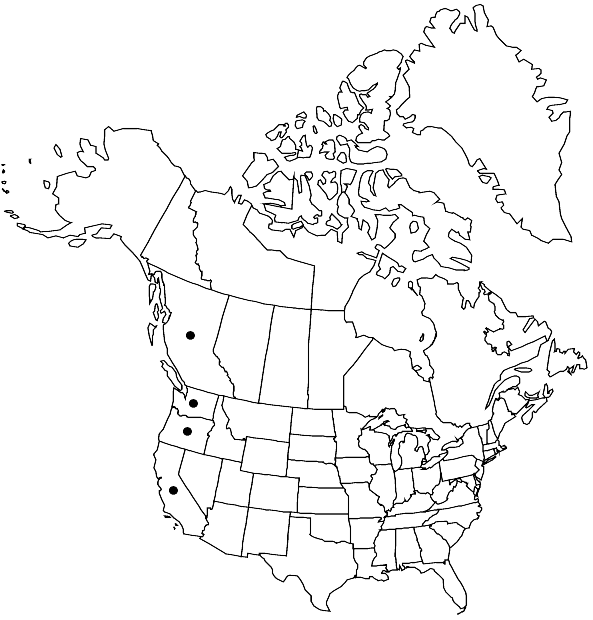Bucklandiella pacifica
in R. Ochyra et al., Cens. Cat. Polish Mosses, 147. 2003,.
Plants medium-sized to rather large, coarse and rigid, loosely or densely caespitose, somewhat lustrous, dark green, olivaceous to yellow or brownish green in the distal part, brown proximally. Stems (1–) 2–5 (–7) cm, creeping, curved-ascending to erect, irregularly branched or almost simple. Leaves erect-appressed when dry, erect-patent when moist, straight to curved, ovatelanceolate, carinate distally, broadly canaliculate proximally, 2.2–3 × (0.5–) 0.7–1 mm; margin broadly recurved to 2/3–3/4 of the way up the leaf on one side, more narrowly recurved to mid leaf on the other side, 1-stratose, entire; apices acute to narrowly obtuse, muticous, usually with minute teeth owing to protruding cell ends; costa subpercurrent to percurrent, in transverse-section strongly convex abaxially, (70–) 80–120 (–160) µm wide near the base, 50–65 µm distally, 2-stratose in the distal and median parts, with 2–4 enlarged adaxial cells, reniform, 2–3 (–4) -stratose, with 3–6 (–7) adaxial cells proximally; laminal cells 1-stratose throughout, smooth to pseudopapillose; basal laminal cells elongate, 35–65 × 7–9 µm, sinuose-nodulose, moderately thick-walled; alar cells usually differentiated in 3–5 cell rows, thick-walled, porose, yellowish-brown to orange, enlarged, quadrate to short-rectangular; supra-alar cells scarcely differentiated or undifferentiated, not forming a marginal border; medial laminal cells rectangular, 25–40 × 7–9 µm; distal laminal cells isodiametric, quadrate, oblate or roundedquadrate to short-rectangular, 7–15 × 7–9 mm. Inner perichaetial leaves strongly differentiated, ovate, hyaline. Seta brownish, 5–8.5 mm. Capsule brown, obloid to long-cylindric, 2–3.7 × 0.45–0.7 mm; operculum straight, 1–1.5 mm; peristome teeth 300–600 µm, deeply 2-fid, papillose, erect to widely flaring when dry, arising from a fairly short, 40–50 µm, basal membrane. Spores 14–21 µm.
Habitat: Dry or seasonally submerged to occasionally irrigated, usually exposed boulders, cliffs, less often on perennially wet outcrops and moist, diffusely lit boulders and rock ledges, as well as on soil over rocks and sometimes on sandy soil, predominantly on acidic, less often on basic but not strongly calcareous substrates
Elevation: low to moderate elevations (0-1100 m)
Distribution

B.C., Calif., Oreg., Wash.
Discussion
Bucklandiella pacifica occurs at low elevations from southern Vancouver Island southwards to central California. It is the only species of the genus in North America that has consistently muticous leaves lacking a hyaline hair-point. In addition, the species is readily distinguished by the entirely unistratose laminal cells, including leaf margins, narrowly obtuse to acute leaf apex, absence of a basal marginal border, differentiated alar cells sometimes forming an auriculate group, and long-cylindrical capsules with prominently flaring peristome teeth. Bucklandiella pacifica has often been mistaken for Codriophorus depressus, a narrow endemic of California, Nevada, and Oregon (for differences see under 5. Codriophorus depressus), and it is likely to be mistaken for C. ryszardii and muticous ecads of C. varius. However, those species are immediately distinct by having distinctly papillose laminal cells with large, flat papillae. The former is additionally easily distinct in having erose-dentate and cristate leaf apices, longer leaves (3.2–4 mm), and stronger costa that is 4-stratose with 5–8 large adaxial cells in the basal part, whereas the latter has a distinct 1–2-seriate basal marginal border and distinctly plicate leaf base.
Selected References
None.
Lower Taxa
"um" is not declared as a valid unit of measurement for this property."-stratose" is not declared as a valid unit of measurement for this property.
